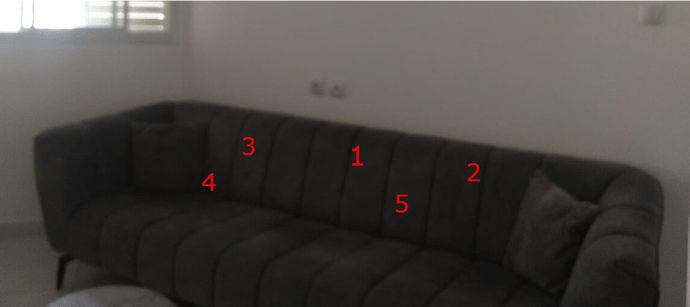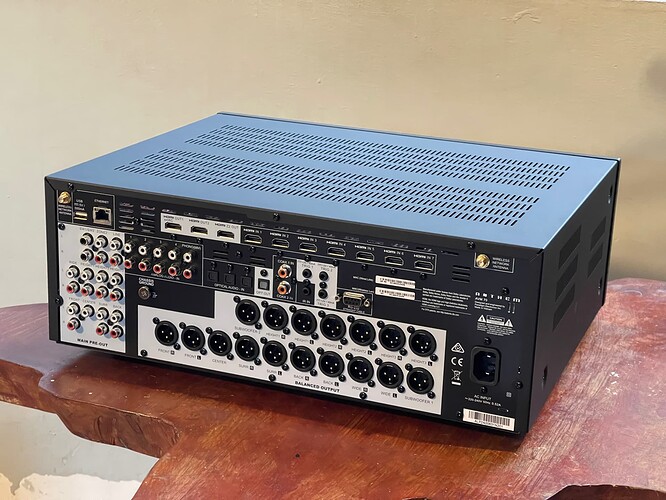Thanks for the reference,… patiently counting down the days. ![]()
TIPS ON ADVANCE ARC SETTINGS
Here’s my tips for the advanced settings. As always, you should try to see if it works for you as every room is unique and the results is contingent on the ARC calibration results. As the saying goes, “garbage in, garbage out”…The advanced setting can only help to smooth out the “rough edges” and make it sound more “refined” than the default settings. With that out of the way, let’s dive in…
I will be using my mains (KEF R100) in this segment.
Tilt Start Frequency
By default, the Tilt Start Frequency range is set at 100Hz. This isn’t always ideal but it is not hard to see why 100Hz since ARC crossover my Mains at 100Hz.
The black curve is the “Target Curve” much like Dirac setting an optimum target curve for the “corrected” frequency curve to follow as close as possible. If we zoom in further on the graph, we can see that my KEF R100 starts to roll-off at about 2,800Hz to 3KHz thereabouts.
Use 3KHz as the roll-off point, we will set the Tilt Start Frequency to roll-off at the same frequency so that the target curve will stick to the natural frequency roll-off of my Mains. Next, adjust your Tilt Level (dB) to get the target curve to touch the “corrected” (purple) frequency curve. I ended up with -2.5dB.
Room Gain
As mentioned in my last post, you can set the Room Gain at 3dB as a baseline starting point. Adjust either up or down depending on how much bass energy you want. You will know it after playing some of your favourite movie and music content with a fair amount of bass in the content.
Room Gain Center Frequency
By default, ARC sets mine at 200Hz (for me, not sure it will be different for others though). This is a crucial point for getting the chest slamming bass and the overall bass energy right. You will need to experiment with the different setting. In a nutshell, if you “shift” the Room Gain Center to lower, say 150Hz, there will be a drop in the overall SPL level and that helps with “boomy and bloated bass” a lot. Conversely, if you want more “rumble” and a “fuller” and more “energetic” bass, you can shift the centre to 200Hz or higher. As you have guess it by now, both Room Gain and Room Gain Center settings are interconnected. If you find the bass to be too “boomy” which drowns out the surround effects or make the dialogue muffled, you can either lower the Room Gain or shift its centre to 150Hz (minimum). Again, experiment is the key…it is your room, your speakers and your subwoofers. Experiment until you get a good combination of both.
Deep Bass Boost
This setting is specifically made for what I will called “bum shaking” and “pants flapping” bass. It generally affects the sub-modal frequency range (20Hz - 50Hz) where bass is not localisable. For those who wanted to have a “bass-shaking” effects, this is the setting that you will want to play with. I have set mine at 2dB. Since I already have a bass shakers installed behind my 2-seater, I need not push it too hard.
Maximum Correction Frequency
I have briefly touched on this in my last post as well. If you feel that the sound stage is not wide or there is a lack of that “cinematic” scope or feel when watching a blockbuster movie, try to lower it from the default 5KHz to 500Hz. It will make a drastic difference. The theory goes that over-correction for a good pair of Mains can actually “rob” you of the dynamics of your speakers. This is especially so when your Mains are a very capable pair of speakers. Besides, correcting the frequency range to achieve a flatter response may actually be counter-intuitive since any correction above 250Hz - 500Hz may unwittingly destroy the dynamics of your speakers.
Try the above advanced tips and let me know whether it works for you… 
can you make a guide how to calibrate arc genesis please?
I see there is still a significant dip at 100-125Hz, were you not able to even this out with 3 subs?
Eh… That’s my front mains, not subwoofer graph. ![]()
Calibration is the simple part. Just make sure it is properly placed in 5 positions with varying distance and height. I have already mentioned in my last 2 posts on the pre calibration things that one needs to do (read the tips section on ARC calibration) and then post ARC, apply the advance tips I have shared.
Here’s a reply from Anthem in one of my conversations with them when reporting bugs. It seems Anthem is currently working on the mobile ARC app for the new models and more importantly they are back on the original timeline to roll out the features they’ve promised the customers…
I have a sofa which is attached to the back wall and i do not have the option to place the calibration microphone at 4+5 points as in the manual.
Attach a picture and i would be happy for suggestions that will help me eith the problem of where to place the microphone at this points.
My MLP is also against the rear wall so I place the mic between 1-2 and 2-3.
Based on what I see…it is hard to get good surround effects in your case. Anyway, for mic positioning, you can do it in the following sequence.
Position (1), (2) & (3):
Approximately 60cm apart from each of the 3 positions with varying degrees of height. For position (1), you can go at ear-level, for (2) & (3), you can elevate higher a bit.
Position (4) & (5):
Place in front of the seat in between (2) & (3).
The figure looks ok. As per my advice on the Anthem Lover’s FB page, pls try to re-do your calibration without the Rotel power amp and see if it improves the trim values. But make sure you follow the guide.
Finely i sucsed to calibrate and get the true balanced levels.
Fl -2db
C 0db
Fr -1.5db
Sl +3db
Sr +3.5db
Hl -2.5db
Hr -2.5 db
Sw -2.5 db
Yup… Saw your FB post and I’m glad that you finally nail it. Enjoy!
Congrats 
 I’m sure you will love it!
I’m sure you will love it!
Congratulations!! 


Congrats, me too have just ordered the AVM70 last week. Now patiently waiting for stocks to be in. May I asked if u will be using the XLR or RCA to the amp? What amp will u be using?
I’m keeping my Krell for now, can use both options RCA or XLR - will be using XLR as it’s better against long noise.
The subs is limited to RCA unfortunately.















